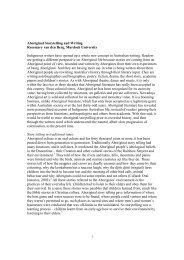Big Chief Little Wolf: Wrestling, Radio and Folklore in ... - [API] Network
Big Chief Little Wolf: Wrestling, Radio and Folklore in ... - [API] Network
Big Chief Little Wolf: Wrestling, Radio and Folklore in ... - [API] Network
You also want an ePaper? Increase the reach of your titles
YUMPU automatically turns print PDFs into web optimized ePapers that Google loves.
Everyday Wonders<br />
‘sports enterta<strong>in</strong>ment’, a classification that recognises the great skill <strong>in</strong>volved, as<br />
well as the highly theatrical essence. It is a spectacle that comb<strong>in</strong>es athleticism,<br />
genu<strong>in</strong>e wrestl<strong>in</strong>g holds, <strong>and</strong> ruggedness with traditions of theatre, dance, comic<br />
enterta<strong>in</strong>ment, pantomime <strong>and</strong> tragi-drama.<br />
Professional wrestl<strong>in</strong>g is based on the catch-as-catch-can style, or American<br />
style, which developed on the American western frontier about 130 years ago. The<br />
tough men who settled the wild west <strong>in</strong>cluded a mix of European nationalities <strong>and</strong><br />
Englishmen from different regions of Engl<strong>and</strong>, plus a fair few Irishmen. <strong>Wrestl<strong>in</strong>g</strong><br />
was a common, popular, past-time, <strong>and</strong> each group brought with them the wrestl<strong>in</strong>g<br />
traditions of their diverse regional backgrounds: the Cornish had a special style <strong>and</strong><br />
wore jackets for wrestl<strong>in</strong>g; there was a Devon style, <strong>and</strong> styles from Lancashire<br />
<strong>and</strong> Irel<strong>and</strong>. The latter two had a big impact <strong>in</strong> the development of the catch-ascatch-can<br />
style, which basically is a style where anyth<strong>in</strong>g goes, subject to a h<strong>and</strong>ful<br />
of restrictions. The aim of catch-as-catch-can is to p<strong>in</strong> the opponent’s shoulders for<br />
the count of three, or to force him to submit. Very few parts of the body are<br />
prohibited from be<strong>in</strong>g held. This itself, a hundred years ago, was considered<br />
sensational, as the Greco-Roman style, which was also very popular at that time,<br />
prohibited any manoeuvres below the waist. 6<br />
Professional wrestl<strong>in</strong>g <strong>in</strong> Australia may be traced to the 1880s, when men such<br />
as Donald D<strong>in</strong>nie <strong>and</strong> Professor William Miller would meet on stage at carnivals<br />
<strong>and</strong> theatres, or <strong>in</strong> large taverns, or outdoor arenas, around Australia <strong>and</strong> wrestle <strong>in</strong><br />
bouts that could last several hours. Very few holds would be applied <strong>and</strong>, while<br />
such wrestl<strong>in</strong>g made for <strong>in</strong>terest<strong>in</strong>g read<strong>in</strong>g <strong>in</strong> newspapers, which provided detailed<br />
reports, it could not be susta<strong>in</strong>ed as a viable commercial form of enterta<strong>in</strong>ment once<br />
radio became a mass media <strong>in</strong> the 1920s.<br />
The advent of radio, as a mass phenomenon, speeded up the action <strong>in</strong> professional<br />
wrestl<strong>in</strong>g. Strict time-limits <strong>and</strong> the rounds’ system, where a contest might go for a<br />
specified eight or ten eight-m<strong>in</strong>ute rounds, were <strong>in</strong>troduced, along with a greater<br />
number, <strong>and</strong> wider variety, of wrestl<strong>in</strong>g holds <strong>and</strong> manoeuvres. Dur<strong>in</strong>g the<br />
Depression, US footballers like Gus Sonnenborn <strong>and</strong> Joe Savoldi needed work dur<strong>in</strong>g<br />
the non-football season, so they entered the ‘rassl<strong>in</strong>’ r<strong>in</strong>g’ <strong>and</strong> were <strong>in</strong>strumental <strong>in</strong><br />
creat<strong>in</strong>g spectacular manoeuvres such as the fly<strong>in</strong>g tackle <strong>and</strong> aerial drop-kick.<br />
This type of action was perfect for radio broadcasts <strong>and</strong>, with proper stadiums<br />
hav<strong>in</strong>g been built around the US <strong>and</strong> Australia from the turn of the century, radio —<br />
like the televised broadcasts of a much later era — served to promote attendance at<br />
the site of the live action.<br />
Back then, radio was as important to home recreation as television is today.<br />
People set aside special times to gather around the wireless, usually <strong>in</strong> the loungeroom,<br />
<strong>and</strong> to listen to their favourite programs <strong>and</strong> serials. Many of my letters refer to the<br />
thrill of listen<strong>in</strong>g to regular radio broadcasts. The follow<strong>in</strong>g excerpt is representative:<br />
In 1937 I was six years of age, liv<strong>in</strong>g with my parents <strong>in</strong> a mud brick home with dirt<br />
floors, covered with l<strong>in</strong>oleum, on a small farm <strong>in</strong> northern Victoria. My special treat<br />
was to be allowed to ‘sit up’ very late, to about 8.00pm or 9.00pm, <strong>and</strong> listen to the<br />
weekly wrestl<strong>in</strong>g broadcasts by 3DB/3LK which we received on a valve radio <strong>in</strong> a<br />
large cab<strong>in</strong>et with an old car battery as the power source.<br />
31


![Big Chief Little Wolf: Wrestling, Radio and Folklore in ... - [API] Network](https://img.yumpu.com/12204748/3/500x640/big-chief-little-wolf-wrestling-radio-and-folklore-in-api-network.jpg)
![Dream and Nightmare in William Gibson's ... - [API] Network](https://img.yumpu.com/49298598/1/184x260/dream-and-nightmare-in-william-gibsons-api-network.jpg?quality=85)

!['Fuck All Editors': The Ern Malley Affair and Gwen ... - [API] Network](https://img.yumpu.com/42446228/1/184x260/fuck-all-editors-the-ern-malley-affair-and-gwen-api-network.jpg?quality=85)
![Polona Petek - [API] Network](https://img.yumpu.com/40542952/1/190x245/polona-petek-api-network.jpg?quality=85)
![to download as a PDF. - [API] Network](https://img.yumpu.com/35170825/1/184x260/to-download-as-a-pdf-api-network.jpg?quality=85)
![Edward Koiki Mabo: The Journey to Native Title - [API] Network](https://img.yumpu.com/33197148/1/184x260/edward-koiki-mabo-the-journey-to-native-title-api-network.jpg?quality=85)
![Gallipoli, Kokoda and the Making of National Identity - [API] Network](https://img.yumpu.com/31766380/1/184x260/gallipoli-kokoda-and-the-making-of-national-identity-api-network.jpg?quality=85)
![Indigenous Knowledge and Pharmaceuticals - [API] Network](https://img.yumpu.com/24108846/1/184x260/indigenous-knowledge-and-pharmaceuticals-api-network.jpg?quality=85)
![Ferals: Terra-ism and Radical Ecologism in Australia - [API] Network](https://img.yumpu.com/13809010/1/184x260/ferals-terra-ism-and-radical-ecologism-in-australia-api-network.jpg?quality=85)
![Dark Tourism and the Celebrity Prisoner - [API] Network](https://img.yumpu.com/4348795/1/184x260/dark-tourism-and-the-celebrity-prisoner-api-network.jpg?quality=85)